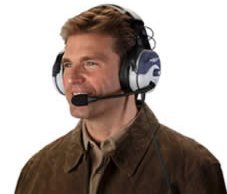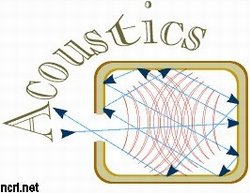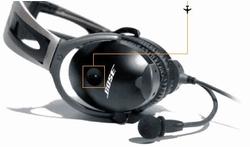From ANR to dB
One thing is for certain in the long wars over whose top-line
headset is the best: customers have better choices than ever.
 At Sun 'n Fun, I spent some time with three of the
premier headset makers, and was able to make time to receive two
presentations. In a future edition of ANN, you'll
see a side-by-side-by-side test of several of today's best ANR
(active noise reduction) headsets; for now, I'll tell you what I
learned at the show.
At Sun 'n Fun, I spent some time with three of the
premier headset makers, and was able to make time to receive two
presentations. In a future edition of ANN, you'll
see a side-by-side-by-side test of several of today's best ANR
(active noise reduction) headsets; for now, I'll tell you what I
learned at the show.
First, there's no free lunch. These sets all cost from several
hundred, to nearly a thousand dollars. They're all better than the
bgest-available sets of just a few years ago, and, considering I
paid over $900 for my Telex ANR set twelve years ago, they're
(relative to inflation) becoming more affordable.
'The myth' is dying, as well it should.
Active Noise Reduction is still somewhat misunderstood. The
principle is that each ear cup has within it, in addition to the
traditional speaker, a microphone, and additional circuitry. The
mic hears noise from the environment and relays that info to the
circuitry; and the speaker then manufactures an identical sound
inside the ear cup -- but exactly out of phase, or "backwards."
That additional sound, the theory goes, exactly cancels the outside
noise. The misunderstanding is that ANR sets cancel ALL the outside
noise -- not just the fatiguing engine drone, but also the "noise"
of passengers, stall horns, gear horns... It's not the way it's
designed; and it's not the way it works in practice.
Engines and props hum. People chatter.
 Modern noise-cancelling sets attack primarily the
engine and propeller noise, which are typically lower-frequency
sounds. 90 Hz (90 cycles per second) is the de facto standard
frequency that is most-attenuated by the circuitry. The higher
frequencies, where gear horns and your passengers' speech
predominate, receive very little, if any, attention from the
noise-canceling circuits. The human voice generally occupies the
200~2000Hz range.
Modern noise-cancelling sets attack primarily the
engine and propeller noise, which are typically lower-frequency
sounds. 90 Hz (90 cycles per second) is the de facto standard
frequency that is most-attenuated by the circuitry. The higher
frequencies, where gear horns and your passengers' speech
predominate, receive very little, if any, attention from the
noise-canceling circuits. The human voice generally occupies the
200~2000Hz range.
Your mother-in-law will still sound quieter in most cabins when
you wear your headset, because the set itself blocks some sound
(plain old "passive attenuation"); but she may be
more-understandable, because your ears won't have to block that
low-frequency sound the engine and prop are making.
Factors:
All the manufacturers agreed, that "any headset is better
than no headset," but they also stressed that it's important
to use the best set you can afford, right from the start. Although
it's tempting as a student to buy a low-cost passive set, your ears
will last longer if you start with a great set, right away. Why
wait until after your hearing is damaged, to start wearing a set
that helps you hear, and protects your diminishing asset? Hearing
damage is continuous and cumulative.
 Several things go into determining 'the right headset' for you.
Perhaps the most-important is individual comfort. Different
peoples' heads are different shapes; some headbands and ear cups
are more-comfortable for some people. A lot of us wear glasses --
how well does the ear cup seal around the temples? Is the clamping
force sufficient, or excessive? Are we flying in a Falconjet, or an
open biplane? In other words, will we wear the set, and will it be
comfortable in our regular use? Heavy clamping forces may be
necessary in the Stearman -- can we lighten the clamping load in
the Extra 400? Most pilots' heads aren't symmetrical; many pilots'
ears aren't both put on at the same "altitude;" everybody's ears
are different, too -- angle, size, and shape... and don't forget
the glasses. Some prefer the plastic, gel-filled earpieces; others
like soft leather and foam. Each has relative advantages and
drawbacks.
Several things go into determining 'the right headset' for you.
Perhaps the most-important is individual comfort. Different
peoples' heads are different shapes; some headbands and ear cups
are more-comfortable for some people. A lot of us wear glasses --
how well does the ear cup seal around the temples? Is the clamping
force sufficient, or excessive? Are we flying in a Falconjet, or an
open biplane? In other words, will we wear the set, and will it be
comfortable in our regular use? Heavy clamping forces may be
necessary in the Stearman -- can we lighten the clamping load in
the Extra 400? Most pilots' heads aren't symmetrical; many pilots'
ears aren't both put on at the same "altitude;" everybody's ears
are different, too -- angle, size, and shape... and don't forget
the glasses. Some prefer the plastic, gel-filled earpieces; others
like soft leather and foam. Each has relative advantages and
drawbacks.
To publish, or not to publish: that's one question.
The Bose people said they don't 'engage in the dB wars,' meaning
that they don't publish numbers about how many decibels' reduction
in outside noise their sets produce. Telex, on the other hand, has
numbers for all their sets. Why the difference?
 The Telex demonstration was a case in point,
demonstrating to me why each company would have its own tactic. The
test, well-constructed for a field demonstration, used an enclosure
with anechoic foam and a large speaker inside, producing calibrated
noise for an aluminum billet "head," on which various headsets were
placed.
The Telex demonstration was a case in point,
demonstrating to me why each company would have its own tactic. The
test, well-constructed for a field demonstration, used an enclosure
with anechoic foam and a large speaker inside, producing calibrated
noise for an aluminum billet "head," on which various headsets were
placed.
First up was the new Bose 'tri-port' set, with perhaps the
lowest clamping force in the industry. Bose, which believes its new
technology allows the mechanical forces to be reduced, also uses
leather-covered foam cups. The result on a block of aluminum is
that the Bose set doesn't "grab" very tightly (and if your
head is smooth aluminum, it won't grab you, either). The Bose set
was tested, and a digital oscilloscope showed noise attenuation on
the adjacent screen. That attenuation curve was preserved, as
another headset was auditioned. Finally, the Telex Spectra 50D (top
photo) was placed on the aluminum 'pilot,' and the test was run
again. Strangely (since this was a Telex demonstration), the Telex
attenuation curve was indistinguishable from a low-cost
competitor's! Our demonstrator opened the test box, saw that he had
placed the Telex set a little off-square on the test head, and
repositioned the headset. Voilà! the Telex headset
outperformed all comers. Then, before I tried on the Telex set, my
demonstrator loosened the clamping force on the headband.
That little demonstration points out that any laboratory test
results, in order to generate comparable data, need to be carefully
controlled; it's also important to note that dB reduction is highly
frequency-sensitive -- and that's a deliberate function of the
circuit's design. Consider also that any lab test, no matter how
fairly-designed and administered, will, by virtue of the fact that
sets are designed to do different things, 'favor' certain designs.
Your own head, though, cares only about what it needs --
not what the results would be on someone else's head, or in a lab.
The tests are important -- they'll narrow your choices;
but don't rely only on the tests, before you send your stack of
hundreds to the nearest pilot shop.
 The Bose demonstration was opposite in approach. I
was invited into the big Bose truck/studio, and subjected to the
noise from a Bradley Fighting Vehicle. [Actually, the noise inside
a real Bradley is in excess of 100 dB at certain frequencies; our
room was limited to 90~92 dB, in the interest of not rendering deaf
any poor soul who pulled his headset off early.] Bose explained
that their design goal was to provide ultimate comfort, with
"enough" noise cancellation. Its magnesium headband, light clamping
force, and protien leather-over-foam earpieces, along with other
features, certainly meet the "comfort" criterion. The 11.5 ounce
set also makes "riding in the Bradley" a tolerable experience. How
many dB of attenuation? I don't know. Was it 'enough?' Sure -- but
would a different set have 'felt' better? I don't know -- I didn't
bring a different set. Would I be happy with the Bose
performance? You bet... but I don't know how convinced I'd
be, unless I tried a lot of sets. Side-by-side -- you gotta do
it.
The Bose demonstration was opposite in approach. I
was invited into the big Bose truck/studio, and subjected to the
noise from a Bradley Fighting Vehicle. [Actually, the noise inside
a real Bradley is in excess of 100 dB at certain frequencies; our
room was limited to 90~92 dB, in the interest of not rendering deaf
any poor soul who pulled his headset off early.] Bose explained
that their design goal was to provide ultimate comfort, with
"enough" noise cancellation. Its magnesium headband, light clamping
force, and protien leather-over-foam earpieces, along with other
features, certainly meet the "comfort" criterion. The 11.5 ounce
set also makes "riding in the Bradley" a tolerable experience. How
many dB of attenuation? I don't know. Was it 'enough?' Sure -- but
would a different set have 'felt' better? I don't know -- I didn't
bring a different set. Would I be happy with the Bose
performance? You bet... but I don't know how convinced I'd
be, unless I tried a lot of sets. Side-by-side -- you gotta do
it.
Why you need to use your own head:
 Do you
want a TSO'd headset, so you don't need auxiliary power? Are you
worried about 'special' battery needs? Do you want stereo? Do you
need a dynamic mic, or do you prefer an electret condenser design?
Left-hand hookup, or right -- or is your headset adaptable, either
way? Do you need adjustable clamping force? Do you wear glasses, or
a hat? How long do you fly, at a stretch -- is weight, by itself, a
major concern? Are you typically rough on equipment -- is cord or
plug design a factor?
Do you
want a TSO'd headset, so you don't need auxiliary power? Are you
worried about 'special' battery needs? Do you want stereo? Do you
need a dynamic mic, or do you prefer an electret condenser design?
Left-hand hookup, or right -- or is your headset adaptable, either
way? Do you need adjustable clamping force? Do you wear glasses, or
a hat? How long do you fly, at a stretch -- is weight, by itself, a
major concern? Are you typically rough on equipment -- is cord or
plug design a factor?
In other words, although you'll get some idea of which headsets
you want to consider from reading the manufacturers' literature,
it's important to actually try them yourself. If you're lucky
enough to do it in your own airplane, that's even better. Several
manufacturers will sell a set on a 30-day return. If your credit
card will stand it, consider 'buying' all of your top choices, and
flying with them, under as-typical conditions as possible. Then,
keep the one you love the best. I've kept that old Telex set for a
dozen years...
 ANN's Daily Aero-Term (04.20.24): Light Gun
ANN's Daily Aero-Term (04.20.24): Light Gun Aero-News: Quote of the Day (04.20.24)
Aero-News: Quote of the Day (04.20.24) ANN's Daily Aero-Linx (04.21.24)
ANN's Daily Aero-Linx (04.21.24) Aero-News: Quote of the Day (04.21.24)
Aero-News: Quote of the Day (04.21.24) ANN's Daily Aero-Term (04.21.24): Aircraft Conflict
ANN's Daily Aero-Term (04.21.24): Aircraft Conflict






